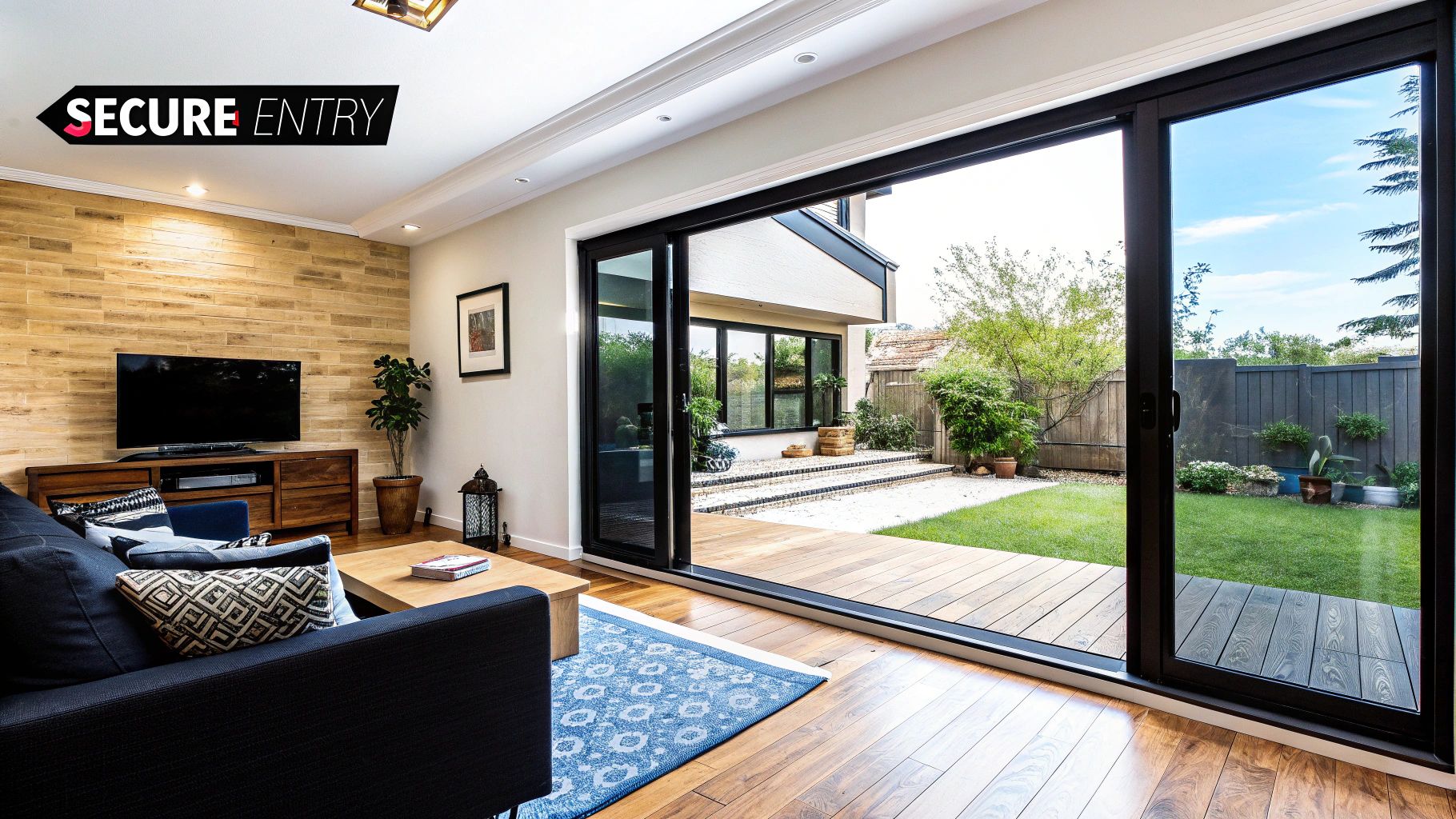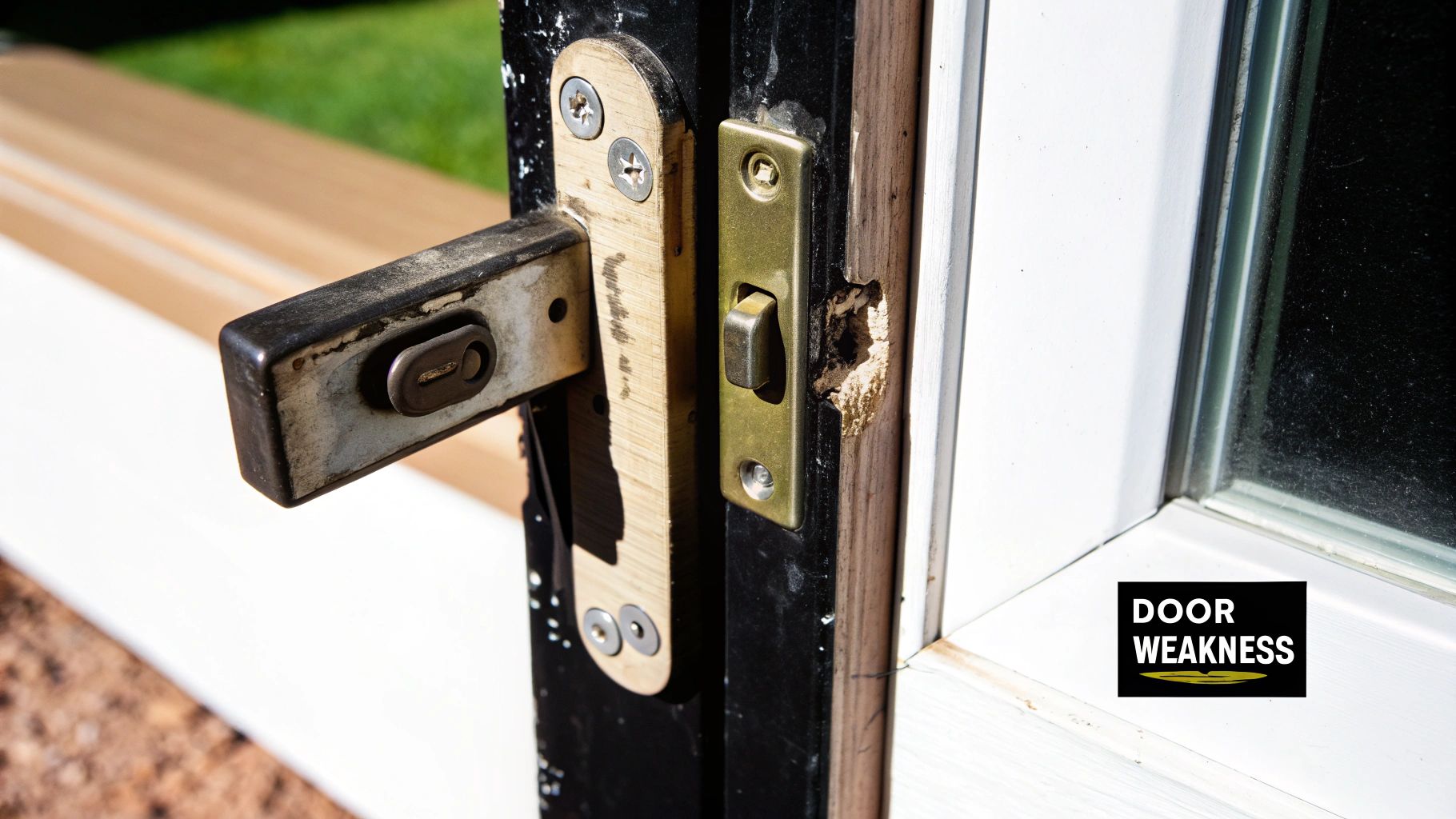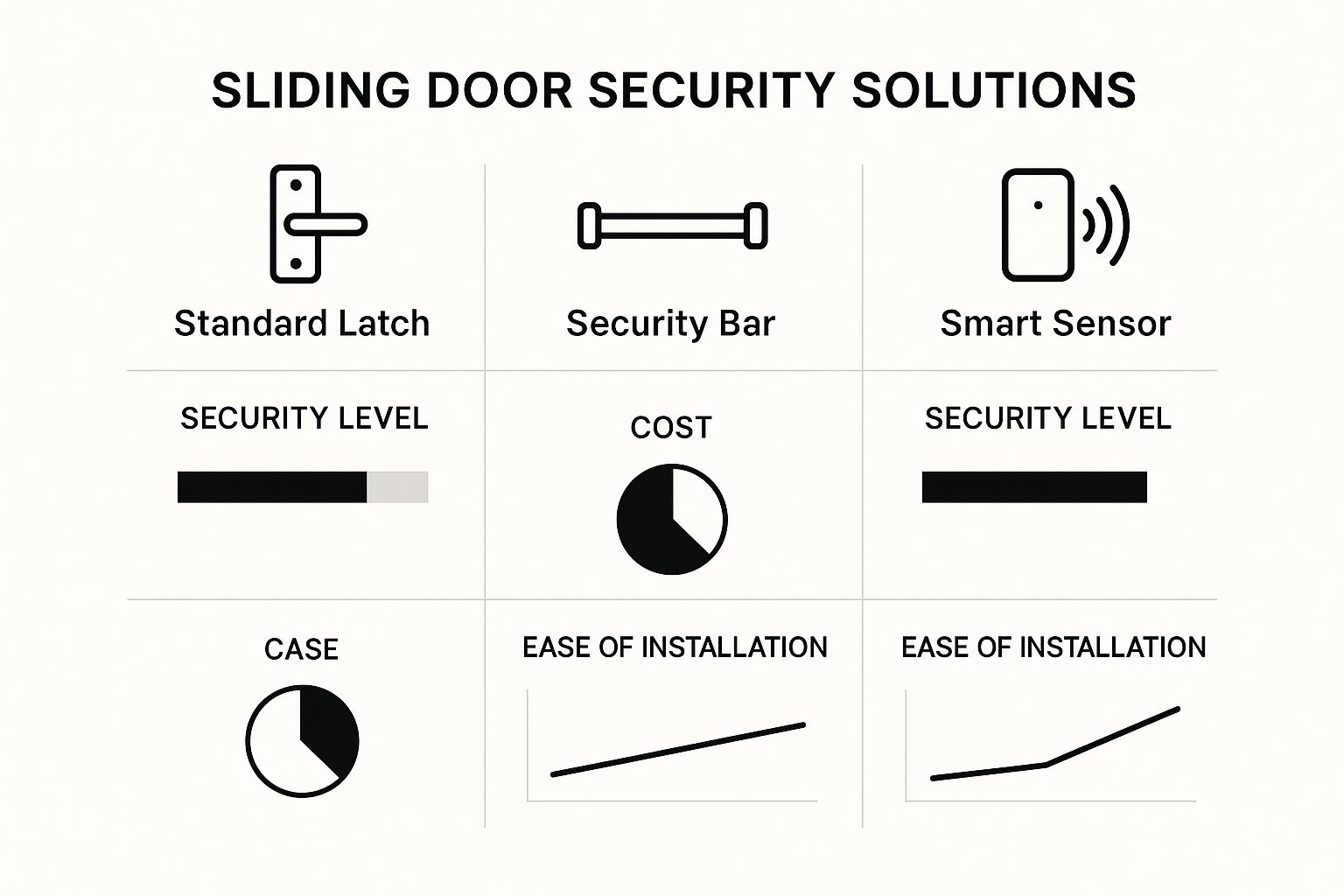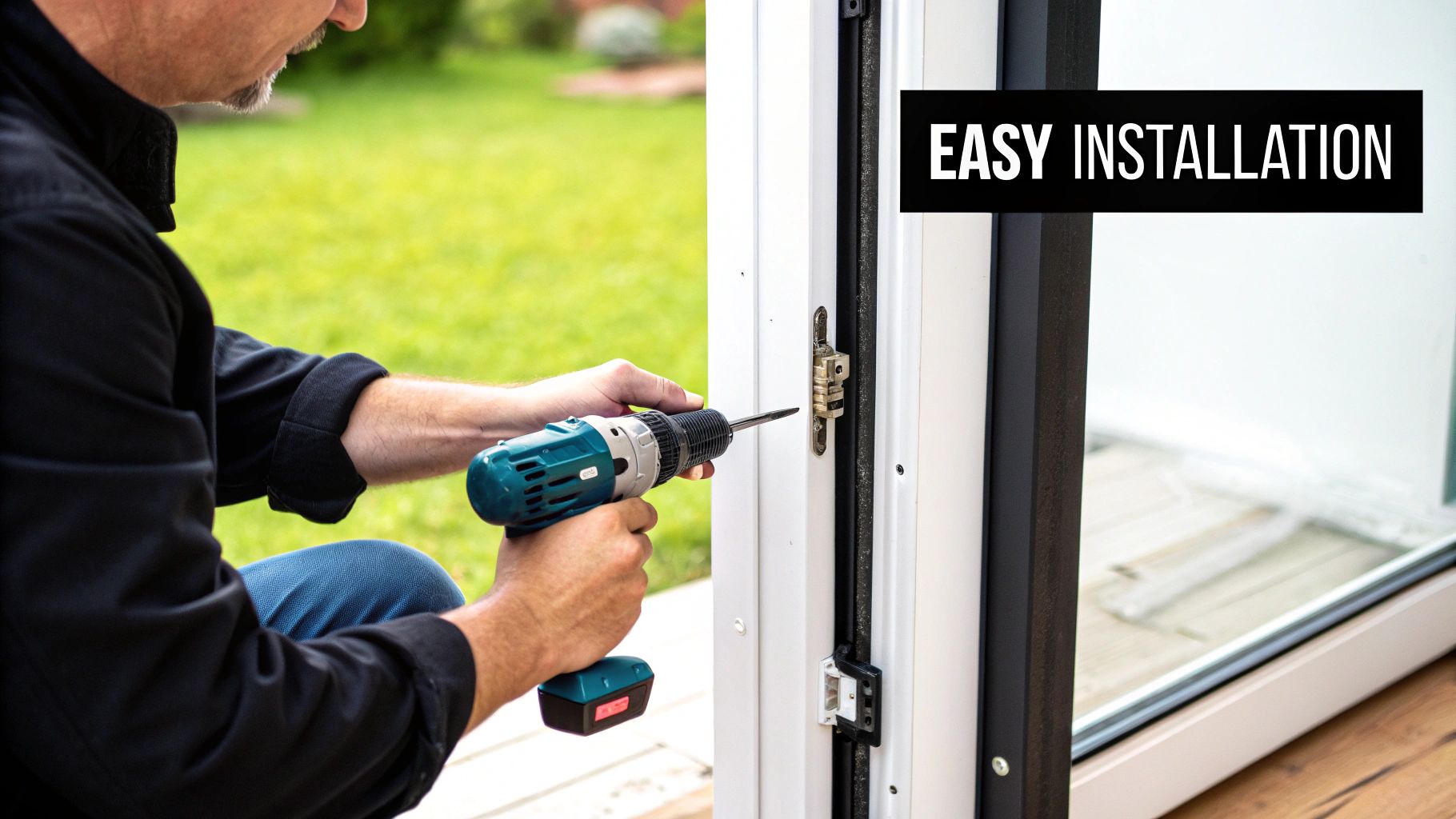Let's be honest, that beautiful sliding glass door that fills your living room with light is also one of the biggest weak spots in your home's security. It's a tough pill to swallow, but the standard latches on most of these doors give a false sense of safety. All too often, they can be bypassed with very little effort, making them an open invitation for intruders.
Why Sliding Doors Are a Top Security Risk

Think about it. That gorgeous door that gives you seamless access to your patio or backyard is often the weakest link in your home's defense. Burglars know this. They're well aware that factory-installed locks are often flimsy, easy to force open, or can even be bypassed by lifting the door right off its tracks.
That little latch that came with your door? It’s more like a screen door hook. Sure, it’ll keep the door from sliding open in a breeze, but it offers almost no real resistance to a determined push. This is exactly why taking a proactive approach to sliding door security isn't just a good idea—it's essential for any homeowner.
The Illusion of Factory-Installed Locks
The core problem is simple: most built-in latches are designed for convenience, not for serious protection. They usually engage at just a single point and can be jiggled, pried, or forced open with alarming ease. This leaves a massive security gap that puts your home at risk.
But here's the good news. You don't need to rip out your entire door and start from scratch to make it secure. The secret is to think in layers.
By combining simple hardware upgrades with modern technology, you can transform a vulnerable entryway into a formidable barrier. This approach addresses multiple weak points simultaneously, creating a defense that is far more effective than any single lock.
Building a Stronger Barrier
A layered defense means you aren't putting all your faith in one mechanism. Instead, you're creating multiple obstacles that an intruder has to deal with. This not only makes a break-in much harder and more time-consuming, but it's also a powerful deterrent that can convince a burglar to move on to an easier target.
Let’s quickly break down the most common vulnerabilities and the best ways to counter them.
Common Sliding Door Weaknesses and Key Defenses
| Common Vulnerability | Primary Security Solution | Impact Level |
|---|---|---|
| Weak Factory Latch | Auxiliary Foot-Operated Lock or Dual-Point Mortise Lock | High |
| Lifting Door Off Track | Anti-Lift Devices or Charley Bar | High |
| Glass Shattering | Security Window Film or Impact-Resistant Glass | Medium |
| Prying Door Open | Sliding Door Security Bar | High |
This table gives you a snapshot of where the problems lie and how to start fixing them. Each solution adds another layer of difficulty for a potential intruder.
Security experts and even real estate professionals often recommend specific enhancements for sliding doors, including:
- Sliding door security bars to physically block the door from being forced open.
- Keyless bolting devices that add a secondary, much stronger, locking point.
- Door viewers or cameras so you can see who is outside without ever having to open the door.
These additions are crucial because, if left in their standard state, sliding doors are far more susceptible to break-ins than traditional hinged doors.
By understanding these risks, you can make smarter decisions to protect your home. For a complete rundown, take a look at our ultimate guide to sliding glass door protection. This guide will walk you through the most significant risks and show you that effective, accessible solutions are well within your reach.
Thinking Like an Intruder to Find Weak Points
To really beef up your sliding door's security, you have to stop seeing it as a beautiful gateway to your patio and start looking at it through a burglar's eyes. They aren't admiring your garden; they're scanning for the path of least resistance. What you see as a convenience, they see as an opportunity.

An intruder’s game is all about two things: speed and silence. They need to get in, get what they want, and get out without making a scene. A standard sliding glass door, with its big pane of glass and often flimsy factory latch, looks like an open invitation compared to a reinforced front door.
This mindset shift is crucial. It forces you to look beyond the simple lock and key and see the whole setup—the glass, the track, the frame—as one interconnected security puzzle. Each part has a potential weakness just waiting for someone to exploit it.
The Art of Lifting a Door Off Its Track
One of the oldest and most shockingly effective tricks in the book doesn't involve breaking the lock at all. It’s about lifting the door right out of its track, completely bypassing the lock.
Picture the door panel like a train car sitting on its rails. If there's just a little bit of vertical wiggle room, a burglar can use a crowbar (or sometimes just their own muscle) to hoist the door up and out of the bottom channel. Once the wheels are clear, they just swing the bottom of the door outward and set it aside. The factory lock is still neatly latched, but it's completely useless.
This single vulnerability is why a door that feels totally secure can be breached in under a minute. It's a wake-up call that you need to secure the door within its frame, not just lock the panel to the side.
Exploiting the Glass and Frame
Of course, if lifting doesn't work, there’s always the more direct approach: going through the glass. The standard annealed glass in many older doors is a burglar’s best friend. It shatters easily and with a surprisingly muffled "pop," especially if they tape the glass first to hold the shards together. One sharp tap in the corner, and they're in.
Even with modern tempered glass, which is much stronger, the goal isn't always to smash the entire pane. All an intruder needs is a hole big enough to reach through and flip the interior thumb-turn lock. Just like that, your own lock becomes their key.
And let's not forget the frame. A flimsy aluminum or vinyl frame can sometimes be bent or pried away from the door panel, creating just enough of a gap to jimmy the latch open.
To really secure your door, you need a layered defense that tackles each of these weak spots head-on:
- Prevent Lifting: Add a few screws to the upper track or install a dedicated anti-lift device. This simple fix eliminates that dangerous vertical play.
- Reinforce Glass: Apply a security film that holds shattered glass in place. It turns a quick smash-and-grab into a noisy, time-consuming struggle.
- Strengthen the Lock: Don't rely on the factory latch. Add a secondary lock, like a double-bolt lock or a foot lock, to anchor the door to the frame at a second, much stronger point.
- Block the Track: A simple security bar is a fantastic visual deterrent and physical barrier. Even if the lock is defeated, the door simply can't slide open.
When you start methodically plugging these holes, you're no longer just locking a door. You're fortifying an entire system, turning a major vulnerability into a serious obstacle.
Right, you know where your sliding door is weak. So what's next? It's time to stop thinking and start doing. Bolting on the right hardware is, without a doubt, the single best thing you can do to make your home safer. We're talking about turning that vulnerable glass panel into a real obstacle for anyone trying to get in.
Let’s walk through the best upgrades, starting with the simplest ones that pack the biggest punch and moving up to the heavy hitters. The idea is to layer your defenses, making it too much trouble for a burglar to even bother.
The Power of a Security Bar
If you do just one thing, make it this: get a good security bar. It's brilliant in its simplicity. It physically wedges the door shut, preventing it from sliding open on its track. It doesn't matter if a burglar jimmies the flimsy factory lock; the door still isn't going anywhere.
You’ve got a few options here, and they all work well:
- Adjustable Pressure-Mounted Bars: These are the go-to for a quick, no-fuss solution. You just wedge it between the sliding part of the door and the door jamb. The pressure holds it tight. No tools, no sweat.
- Folding Security Bars: A more permanent setup. These are mounted right onto the door frame and swing down to block the door. When you don't need it, you just swing it up and out of the way. Super convenient.
- Fixed Security Dowels: This is the old-school method—just a piece of a wooden dowel or PVC pipe cut to fit perfectly in the bottom track. It works, but a solid metal bar designed for the job is always going to be tougher.
A security bar is also a fantastic visual deterrent. A would-be intruder peeking inside will see that bar and know that prying the lock is pointless. That alone is often enough to send them looking for an easier house to hit.
Upgrading to a Double-Bolt Lock
A security bar is a great start, but adding a double-bolt lock really beefs things up. Your standard latch grabs the frame at just one point, which is why it’s so easy to pry open. A double-bolt lock, on the other hand, shoots two bolts into the frame—usually one at the top and one at the bottom.
Think about trying to snap one stick versus two sticks held together. That's the difference. The force is spread out, making the door incredibly resistant to being pried open. These locks often need a key on both sides, which adds yet another security layer. It basically turns your sliding door into a solid, fortified wall.
A double-bolt lock is your best defense against forced entry. By anchoring the door at two separate points, it completely cancels out the leverage a burglar needs with a crowbar. Prying attacks become almost useless.
This chart really drives the point home, showing just how much safer a simple hardware addition makes your door compared to relying on that basic latch.

The numbers don't lie. A standard latch offers almost no real protection. But for a small investment in something like a security bar, you dramatically increase how secure that door is.
Comparing Top Sliding Door Security Hardware
Choosing the right hardware can feel overwhelming. To make it easier, here’s a quick breakdown of the most popular options, looking at how secure they are, what they typically cost, and how easy they are for a DIYer to install.
| Hardware Type | Security Level (High/Med/Low) | Average Cost | DIY Friendliness |
|---|---|---|---|
| Security Bar | High | $20 - $50 | Excellent |
| Double-Bolt Lock | High | $40 - $100 | Moderate |
| Anti-Lift Devices | Medium | $10 - $25 | Good |
| Security Film | Medium | $50 - $150 | Moderate |
Each piece of hardware tackles a different vulnerability. For total peace of mind, a layered approach using a combination of these—like a double-bolt lock and an anti-lift device—is the gold standard.
Preventing Door Lifting
Here’s a vulnerability most people completely forget about: lifting the door right off its tracks. It sounds wild, but it happens. Intruders can sometimes just lift the entire door panel up and out. Luckily, the fix is cheap and easy.
- Install Screws in the Upper Track: Drive a few screws into the overhead track, but don't sink them all the way in. Let the heads stick out just a bit. This creates a physical block that stops the door from being lifted high enough to pop out of the bottom track.
- Add Anti-Lift Devices: These are small, purpose-built bits of hardware you install on the top edge of the door. They're designed specifically to stop the panel from being raised.
These little fixes are crucial. They keep the door locked into its frame, which means your powerful new locks can't just be bypassed. A strong door needs a strong frame to work. If you want to go even further, check out our guide on how to reinforce a door frame for a truly secure setup.
We're not the only ones focused on this. The market for sliding door hardware was valued at $2.51 billion and is expected to hit $3.52 billion soon. That growth is all about people demanding safer, tougher doors for their homes and businesses. It's a clear sign that strong security is no longer an afterthought—it's becoming a standard feature.
Integrating Smart Tech for Modern Security

Physical hardware is a great starting point for sliding door security, but to really bring your home's defense into the 21st century, you need to look at what modern tech can do. Think of it this way: while sturdy bars and locks can stop a brute-force attack, smart devices and reinforced glass create an active, intelligent system. You're moving beyond simply blocking an intruder to actively detecting, deterring, and alerting you to their presence in real time. That's where true peace of mind comes from.
The first, most obvious place to start this upgrade is the giant pane of glass itself. This is where security film comes in. It’s a transparent polyester layer that a professional applies to the inside of the glass. Just imagine it as invisible armor for your door.
Now, it won't make the glass completely unbreakable, but it does something arguably more important: it holds the pane together even after it’s been shattered. This simple addition accomplishes two critical goals. It makes getting in much, much harder—and a whole lot louder. Instead of a quick, quiet pop, a burglar has to keep smashing the glass, creating a racket and buying you precious time for your other security measures to kick in.
Creating a Digital Perimeter with Smart Sensors
With the glass reinforced, the next step is to wrap your door in a digital tripwire. This is where smart sensors turn a passive entry point into a fully monitored zone. These small, often wireless gadgets are the eyes and ears of your modern security setup.
For sliding doors, two types are particularly effective:
- Contact Sensors: These are simple two-piece devices. One part sticks to the door frame, the other to the sliding panel. When the door opens and the connection is broken, it sends an immediate signal to your security system, which can trigger an alarm or ping your phone.
- Glass-Break Sensors: This is a neat piece of tech. It’s a specialized microphone that's tuned to listen for the exact acoustic frequency of shattering glass. If it hears that sound, it instantly triggers an alarm. Often, a single sensor can cover an entire room's worth of windows, including your sliding door.
By adding these sensors, you're getting notified the moment a breach happens, not minutes later. This instant awareness is the bedrock of good home security, giving you, or the police, a chance to respond immediately.
The Rise of Smart Locks for Sliding Doors
The final piece of this smart tech puzzle is the lock itself. While they're not as common as the ones for regular swinging doors, specialized smart locks for sliding doors are gaining a lot of ground. These devices can replace or work alongside your current lock, connecting directly to your home's Wi-Fi.
A smart lock brings some serious convenience and security benefits to the table. You can lock or unlock the door from anywhere using your phone—perfect for those "Did I remember to lock the back door?" moments. You can also grant temporary access to a guest or contractor without handing out a physical key.
But the real magic happens when you tie it all together. Imagine a glass-break sensor is triggered. Your system can instantly check that the smart lock is engaged, turn on all the connected lights, and send a notification to your phone with a live feed from a nearby camera. This is how you build a layered, responsive defense system that works together. For more strategies on layering your security, our guide offers some excellent sliding glass door security tips to protect your home and helps you build a truly solid plan.
Taking Matters into Your Own Hands: DIY Installation and Maintenance
Alright, you've done the research and picked out your hardware. Now it's time to turn that knowledge into real-world protection. Many of the best security upgrades for sliding doors are surprisingly simple to install yourself, making for a perfect weekend project that pays off big time in peace of mind.
This guide is all about getting your hands dirty and making your home safer. We'll walk through installing the most common hardware and then cover the simple upkeep that keeps your security rock-solid for years to come.
Installing Your New Security Gear
Getting hands-on with your home's security is incredibly empowering. Don't be intimidated! Here’s a quick rundown on how to tackle three of the most effective DIY upgrades.
-
Fitting a Security Bar: This is often the fastest and easiest win. For the classic pressure-mounted bar, you just adjust the length until it's wedged tightly in the track between the moving door and the frame. If you opted for a folding bar, you'll need to mount its bracket to the door frame with a couple of screws. Either way, the goal is simple: create a physical block that won't budge.
-
Adding an Auxiliary Lock: Installing a secondary lock, like a foot-operated or double-bolt lock, gives you a much stronger anchor than the flimsy factory latch. This usually involves drilling a few small pilot holes into the door frame and panel, then securing the new lock with the screws it came with. Just remember the old carpenter’s rule: measure twice, drill once.
-
Applying Security Film: This one takes a bit more patience and a very clean space to work. First, scrub that glass until it's spotless. Next, grab a spray bottle with water and a tiny drop of baby shampoo, and spritz the glass and the sticky side of the film. Carefully lay the film on the glass and use a squeegee to push all the air bubbles and water out, working from the center to the edges.
A security device is only as good as its upkeep. Think of it like a car—you wouldn't skip oil changes and expect it to run forever. Regular checks ensure your locks and bars work perfectly when you need them most.
The Simple (But Crucial) Maintenance Checklist
Security isn't a one-and-done job; it's a habit. A well-maintained door slides smoothly and stays secure. Over time, a little neglect can lead to misalignment and worn-out parts, creating the very gaps you're trying to prevent.
Try to work these simple checks into your regular home maintenance routine:
- Keep the Tracks Clean: It’s amazing what can end up in a door track—dirt, leaves, pet hair, you name it. All that gunk can throw the door off-kilter, making it easier to pry or lift. A quick pass with a vacuum and a stiff brush once a month makes a world of difference.
- Check the Rollers: The little wheels at the bottom of your door do all the heavy lifting. If they get worn down or out of alignment, the door can sag, creating gaps at the top or bottom. Most have adjustment screws that let you raise or lower the door until it sits perfectly square in the frame.
- Inspect Seals and Weatherstripping: Cracked or worn-out seals might seem like a weather issue, but they can also make a door feel loose and less structurally sound. A tight fit is a more secure fit.
For a deeper dive into upkeep, checking out some sliding door maintenance tips for smooth operation will give you the full picture on keeping your door in prime condition.
By putting in just a little time on installation and upkeep, you take back control over one of your home’s most important entry points.
Answering Your Top Security Questions
As you start to really think about securing your home, it’s only natural for questions to pop up, especially about something as specific as sliding door security. Getting into the details of different security measures is what helps you build a defense that’s not just strong, but a perfect fit for your home and how you live. Let’s tackle some of the most common questions I hear from homeowners.
Is a Security Bar Enough to Secure My Door?
A good, solid security bar is a fantastic place to start. It’s also a powerful visual deterrent. By physically bracing the door so it can't slide open, you’ve immediately shut down one of the most common ways burglars force their way in. It’s a simple, effective upgrade right off the bat.
But for real peace of mind, a layered approach is always the way to go. Think of the security bar as your first line of defense. When you combine it with other tactics—like security film to keep the glass from shattering or a double-bolt lock for a second, stronger anchor point—you create a multi-faceted barrier. You're covering several weak spots at once.
A layered security strategy is exponentially more effective. It forces an intruder to defeat multiple, distinct systems, which takes more time, creates more noise, and significantly increases the chances they will simply give up and move on.
How Can I Secure a Door on an Upper-Floor Balcony?
It’s easy to overlook them, but upper-floor sliding doors are still a potential weak spot that shouldn't be ignored. While they aren't targeted as often, the main threat is still someone prying or lifting the door to get inside.
For these doors, the key is to install a quality keyed lock or a double-bolt lock to stop them from being jimmied open. And believe it or not, even on a higher floor, a security bar is still a great physical and visual deterrent. You should also make sure the door can’t be lifted out of its track—check that the rollers are adjusted correctly or, for even better protection, add anti-lift screws to the upper channel.
Are Smart Locks a Secure Option for Sliding Doors?
Absolutely. Modern smart locks designed specifically for sliding doors can be a very secure and convenient choice. One of their biggest pluses is that they can eliminate human error. You can check that the door is locked from anywhere, get an alert if it's opened, and even tie it into your bigger home security system.
The trick is to choose a smart lock from a reputable brand known for both its sturdy physical build and its strong digital encryption. Just remember, it should be part of your security setup, not the only thing you rely on.
These principles of layered security don't just apply to doors. You can learn more by reading our top tips for home window security, as a lot of the same ideas can help you build a complete defensive perimeter around your home.
Ready to upgrade to doors that are designed with security in mind from the ground up? Gladiator Window and Doors specializes in massive, high-performance sliding doors that combine breathtaking aesthetics with robust, modern security features. Get the best price in the USA and a superior warranty by visiting us at https://gladiatorwindowanddoors.com to get your custom quote.





















































































